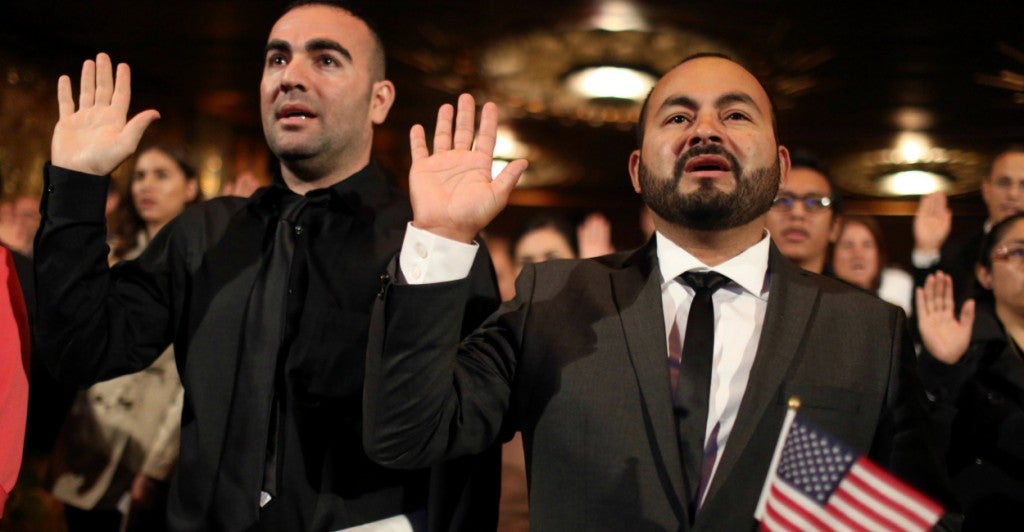During our last era of high immigration, remembered now as the “Ellis Island” age, our leaders would use the Fourth of July to stump for something once quaintly known as Americanization. Theodore Roosevelt, Woodrow Wilson, Louis Brandeis—they all did it, with stirring speeches about bringing new immigrants fully into the American dream.
Presidential candidates, take note. One of the best ways to honor and safeguard our independence today is to start a debate on patriotic assimilation.
For centuries, America welcomed succeeding surges of immigrants with an invitation to join a unique American culture that includes specific principles and virtues. Then, in the 1970s, our elites decided to reverse course, and started promoting sectarianism.
We’ve never really had a debate on what is nothing less than a complete overhaul of the organizing principle of this most diverse of nations. The decisions that led us here were bureaucratic and incremental. Congress passed a law here, federal agencies issued a rule there, and the courts made decisions hither and yonder.
Before we knew it, we had shifted from more than two centuries of perfecting the melting pot to a system of adversarial multiculturalism. Rather than welcoming legal immigrants as new members of our national family, today’s coercive diversity works differently: Immigrants are immediately categorized into bureaucratic, pan-ethnic “minority” groups such as “Hispanic” or “Asian,” each with an ascribed set of supposed cultural norms to which they are expected to conform.
Those who support such balkanization create a divisiveness that not only flouts our proud tradition of legal and ordered immigration—it puts the whole nation at risk.
To see why, consider the last large wave of immigrants, those 20 million or so who entered through Ellis Island between 1890 and 1924. They went through the assimilation process and came out at the other end as “the Greatest Generation“—and went on to face down the Depression and defeat both Nazism and Communism.
People sacrifice for causes that are bigger than themselves—when they’re all in it together. As the philosophers of Greece, Rome and the Enlightenment understood, that requires love of country. Will a future nation of bickering factions rise to the next existential challenge?
The founders whose achievements we celebrate today doubted it. They understood they had a teeming nation where Germans, the Dutch, the French and the Scots-Irish already accounted for one-fifth of the population by 1790. Without national unity, the new republic would flounder.
Alexander Hamilton put this sentiment best when he wrote, “The safety of a republic depends essentially on the energy of a common national sentiment; on a uniformity of principles and habits.”
As long as immigrants possessed the right virtues and fully embraced our country as individuals, not as groups, they would be welcome, however. In a letter to Vice President John Adams, President Washington was probably the first to use the term assimilation when he expressed the hope that, “by an intermixture with our people, they, or their descendants, get assimilated to our customs, measures, and laws: in a word, soon become one people.”
The virtues of the new republic were taught to the citizenry in a system of “Common Schools” that arose throughout 19th-century America. They had, as Mark Edward DeForrest put it, “a large role in assimilating and educating the offspring of the immigrants then moving into the United States from Europe.”
Germans, Scandinavians and Irish who came to America in the mid-1800s benefited from this instruction into republican principles (with a small R). And when the Ellis Islanders showed up—from Italy, Eastern Europe, Jewish ghettos, Lebanon, Armenia, etc.—America renewed this effort.
In New York, where the vast majority of immigrants landed and stayed, the state legislature in 1898 passed a law “to encourage patriotic exercises” in “the schoolhouses of the state.”
Immigrants and their descendants learned how to strike the right balance between pride in the land of their ancestors and its culture and love for their new country. Every step along the way, from Washington on down, our leaders and institutions confidently stood up for the idea that, as Woodrow Wilson put it, “America does not consist of groups.”
We don’t have to replicate the methods that served this country of immigrants well from the 18th to the 20th century. But we shouldn’t do the opposite: Segregate immigrants into groups and then teach them to deride America (If anyone doubts this is what we do, please open Howard Zinn’s “A People’s History of the United States,” to this day Amazon’s No. 1 bestselling textbook in political ideologies).
This Independence Day, let’s consider reaffirming that the dream of freedom doesn’t belong split up in boxes, but rather, that it can be shared by all those who look to being an American first.
